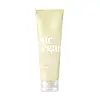What's inside
What's inside
 Key Ingredients
Key Ingredients

 Benefits
Benefits

 Concerns
Concerns

 Ingredients Side-by-side
Ingredients Side-by-side

Water
Skin ConditioningGlycerin
HumectantSodium Cocoyl Isethionate
CleansingDaucus Carota Sativa Root Extract 10%
Skin ConditioningPotassium Cocoyl Glycinate
Hydroxypropyl Starch Phosphate
1,2-Hexanediol
Skin ConditioningButylene Glycol
HumectantPotassium Cocoate
EmulsifyingPolyquaternium-67
Daucus Carota Sativa Root Powder
Skin ConditioningPogostemon Cablin Leaf Oil
MaskingEthylhexylglycerin
Skin ConditioningCitrus Aurantium Bergamia Fruit Oil
MaskingDisodium EDTA
Rosmarinus Officinalis Leaf Oil
MaskingPelargonium Graveolens Flower Oil
MaskingEucalyptus Globulus Leaf Oil
PerfumingAllantoin
Skin ConditioningCitric Acid
BufferingDaucus Carota Sativa Seed Oil
EmollientSqualane
EmollientSodium Hyaluronate
HumectantHydroxypropyltrimonium Hyaluronate
Hydrolyzed Hyaluronic Acid
HumectantSodium Acetylated Hyaluronate
HumectantHyaluronic Acid
HumectantHydrolyzed Sodium Hyaluronate
Skin ConditioningSodium Hyaluronate Crosspolymer
HumectantPotassium Hyaluronate
Skin ConditioningWater, Glycerin, Sodium Cocoyl Isethionate, Daucus Carota Sativa Root Extract 10%, Potassium Cocoyl Glycinate, Hydroxypropyl Starch Phosphate, 1,2-Hexanediol, Butylene Glycol, Potassium Cocoate, Polyquaternium-67, Daucus Carota Sativa Root Powder, Pogostemon Cablin Leaf Oil, Ethylhexylglycerin, Citrus Aurantium Bergamia Fruit Oil, Disodium EDTA, Rosmarinus Officinalis Leaf Oil, Pelargonium Graveolens Flower Oil, Eucalyptus Globulus Leaf Oil, Allantoin, Citric Acid, Daucus Carota Sativa Seed Oil, Squalane, Sodium Hyaluronate, Hydroxypropyltrimonium Hyaluronate, Hydrolyzed Hyaluronic Acid, Sodium Acetylated Hyaluronate, Hyaluronic Acid, Hydrolyzed Sodium Hyaluronate, Sodium Hyaluronate Crosspolymer, Potassium Hyaluronate
Water
Skin ConditioningGlycerin
HumectantSodium Cocoyl Isethionate
CleansingHouttuynia Cordata Extract
Skin ConditioningHydroxypropyl Starch Phosphate
Potassium Cocoyl Glycinate
1,2-Hexanediol
Skin ConditioningCentella Asiatica Extract
CleansingBambusa Vulgaris Water
Skin ConditioningChamaecyparis Obtusa Water
MaskingBetula Platyphylla Japonica Juice
Skin ConditioningHouttuynia Cordata Powder
Skin ConditioningMalt Extract
Skin ProtectingGluconolactone
Skin ConditioningPotassium Cocoate
EmulsifyingButylene Glycol
HumectantAcrylates Copolymer
Ethylhexylglycerin
Skin ConditioningDisodium EDTA
Water, Glycerin, Sodium Cocoyl Isethionate, Houttuynia Cordata Extract, Hydroxypropyl Starch Phosphate, Potassium Cocoyl Glycinate, 1,2-Hexanediol, Centella Asiatica Extract, Bambusa Vulgaris Water, Chamaecyparis Obtusa Water, Betula Platyphylla Japonica Juice, Houttuynia Cordata Powder, Malt Extract, Gluconolactone, Potassium Cocoate, Butylene Glycol, Acrylates Copolymer, Ethylhexylglycerin, Disodium EDTA
 Reviews
Reviews

Ingredients Explained
These ingredients are found in both products.
Ingredients higher up in an ingredient list are typically present in a larger amount.
1,2-Hexanediol is a synthetic liquid and another multi-functional powerhouse.
It is a:
- Humectant, drawing moisture into the skin
- Emollient, helping to soften skin
- Solvent, dispersing and stabilizing formulas
- Preservative booster, enhancing the antimicrobial activity of other preservatives
Butylene Glycol (or BG) is used within cosmetic products for a few different reasons:
Overall, Butylene Glycol is a safe and well-rounded ingredient that works well with other ingredients.
Though this ingredient works well with most skin types, some people with sensitive skin may experience a reaction such as allergic rashes, closed comedones, or itchiness.
Learn more about Butylene GlycolDisodium EDTA plays a role in making products more stable by aiding other preservatives.
It is a chelating agent, meaning it neutralizes metal ions that may be found in a product.
Disodium EDTA is a salt of edetic acid and is found to be safe in cosmetic ingredients.
Learn more about Disodium EDTAEthylhexylglycerin (we can't pronounce this either) is commonly used as a preservative and skin softener. It is derived from glyceryl.
You might see Ethylhexylglycerin often paired with other preservatives such as phenoxyethanol. Ethylhexylglycerin has been found to increase the effectiveness of these other preservatives.
Glycerin is already naturally found in your skin. It helps moisturize and protect your skin.
A study from 2016 found glycerin to be more effective as a humectant than AHAs and hyaluronic acid.
As a humectant, it helps the skin stay hydrated by pulling moisture to your skin. The low molecular weight of glycerin allows it to pull moisture into the deeper layers of your skin.
Hydrated skin improves your skin barrier; Your skin barrier helps protect against irritants and bacteria.
Glycerin has also been found to have antimicrobial and antiviral properties. Due to these properties, glycerin is often used in wound and burn treatments.
In cosmetics, glycerin is usually derived from plants such as soybean or palm. However, it can also be sourced from animals, such as tallow or animal fat.
This ingredient is organic, colorless, odorless, and non-toxic.
Glycerin is the name for this ingredient in American English. British English uses Glycerol/Glycerine.
Learn more about GlycerinHydroxypropyl Starch Phosphate is a modified starch used to help thicken a product.
It is also used in foods.
This ingredient is the potassium salt of coconut acid. Coconut acid is created by mixing fatty acids from coconut oil.
It is an emulsifier, surfactant, and cleanser. According to a manufacturer, it contains glycerin.
Potassium Cocoyl Glycinate is an amino acid-based surfactant and cleaning agent. This ingredient can be derived from animals or plants. It may also be synthetically created from fatty acids of the coconut and glycine.
Potassium Cocoyl Glycinate is a gentle surfactant. Surfactants help gather the dirt, oil, and other pollutants from your skin to be rinsed away. It is a mild cleanser and naturally produces foam.
Sodium cocoyl isethionate is a natural ingredient from coconut oil. It is an ultra gentle cleanser that gives a nice foam without drying the skin or impacting the skin barrier.
The amount of foam created depends on the amount of sodium cocoyl isethionate used in the product.
This ingredient also helps improve the spreadability of a product.
Learn more about Sodium Cocoyl IsethionateWater. It's the most common cosmetic ingredient of all. You'll usually see it at the top of ingredient lists, meaning that it makes up the largest part of the product.
So why is it so popular? Water most often acts as a solvent - this means that it helps dissolve other ingredients into the formulation.
You'll also recognize water as that liquid we all need to stay alive. If you see this, drink a glass of water. Stay hydrated!
Learn more about Water